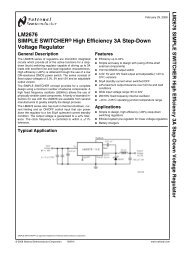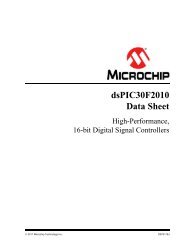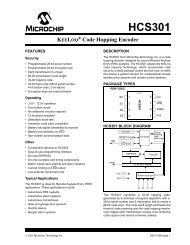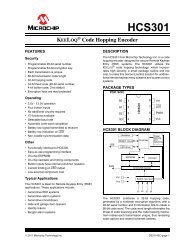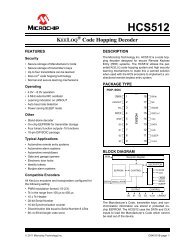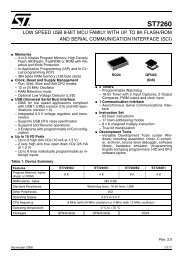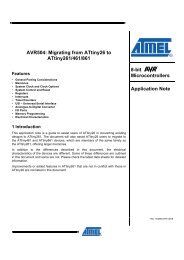You also want an ePaper? Increase the reach of your titles
YUMPU automatically turns print PDFs into web optimized ePapers that Google loves.
<strong>STM32W108C8</strong><br />
Interrupts<br />
Figure 50.<br />
Peripheral interrupts block diagram<br />
interrupts into NVIC /CPU<br />
OR<br />
peripheral interrupt instance<br />
OR<br />
AND<br />
Q<br />
latch<br />
S R<br />
write 1<br />
read<br />
INT_CFGCLR<br />
write 1<br />
INT_CFGSET<br />
AND<br />
AND<br />
INT_periphCFG<br />
Q<br />
latch<br />
S R<br />
read<br />
read<br />
OR<br />
write 1<br />
INT_PENDCLR<br />
Q<br />
latch<br />
S R<br />
INT_periphFLAG<br />
write 1<br />
Q<br />
latch<br />
S R<br />
write 1<br />
INT_PENDSET<br />
read<br />
write 1<br />
INT_MISS<br />
source interrupt events<br />
interrupts from all peripherals<br />
The description of each peripheral's interrupt configuration and flag registers can be found<br />
in the chapters of this datasheet describing each peripheral.<br />
Given a peripheral, 'periph', the Event Manager registers (INT_periphCFG and<br />
INT_periphFLAG) follow the form:<br />
● INT_periphCFG enables and disables second-level interrupts. Writing 1 to a bit in the<br />
INT_periphCFG register enables the second-level interrupt. Writing 0 to a bit in the<br />
INT_periphCFG register disables it. The INT_periphCFG register behaves like a mask,<br />
and is responsible for allowing the INT_periphFLAG bits to propagate into the top level<br />
NVIC interrupts.<br />
● INT_periphFLAG indicates second-level interrupts that have occurred. Writing 1 to a bit<br />
in a INT_periphFLAG register clears the second-level interrupt. Writing 0 to any bit in<br />
the INT_periphFLAG register is ineffective. The INT_periphFLAG register is always<br />
active and may be set or cleared at any time, meaning if any second-level interrupt<br />
occurs, then the corresponding bit in the INT_periphFLAG register is set regardless of<br />
the state of INT_periphCFG.<br />
If a bit in the INT_periphCFG register is set after the corresponding bit in the<br />
INT_periphFLAG register is set then the second-level interrupt propagates into the top level<br />
interrupts. The interrupt flags (signals) from the second-level interrupts into the top-level<br />
interrupts are level-sensitive. If a top-level NVIC interrupt is driven by a second-level EM<br />
interrupt, then the top-level NVIC interrupt cannot be cleared until all second-level EM<br />
interrupts are cleared.<br />
The INT_periphFLAG register bits are designed to remain set if the second-level interrupt<br />
event re-occurs at the same moment as the INT_periphFLAG register bit is being cleared.<br />
This ensures the re-occurring second-level interrupt event is not missed.<br />
If another enabled second-level interrupt event of the same type occurs before the first<br />
interrupt event is cleared, the second interrupt event is lost because no counting or queuing<br />
is used. However, this condition is detected and stored in the top-level INT_MISS register to<br />
Doc ID 018587 Rev 2 178/215





